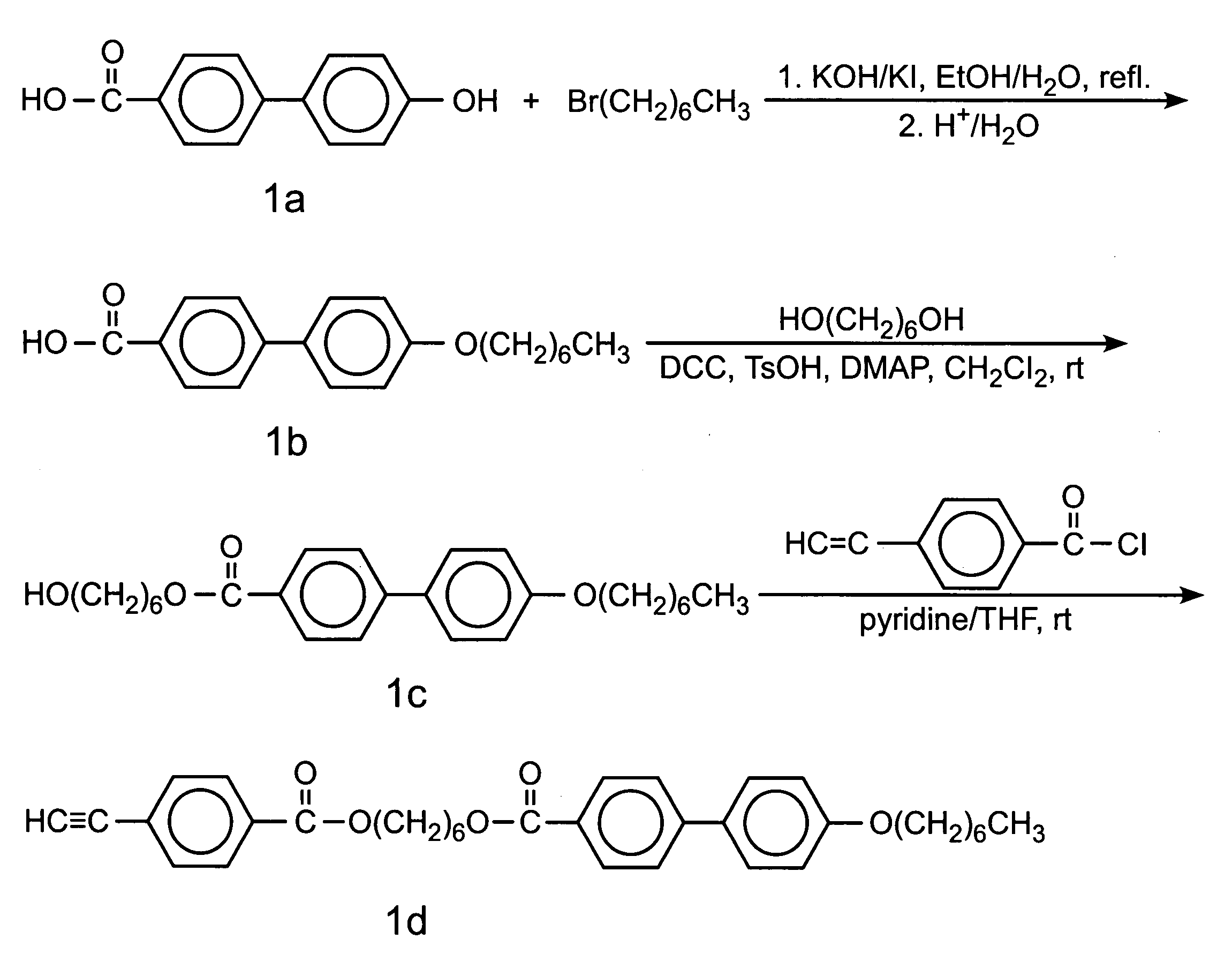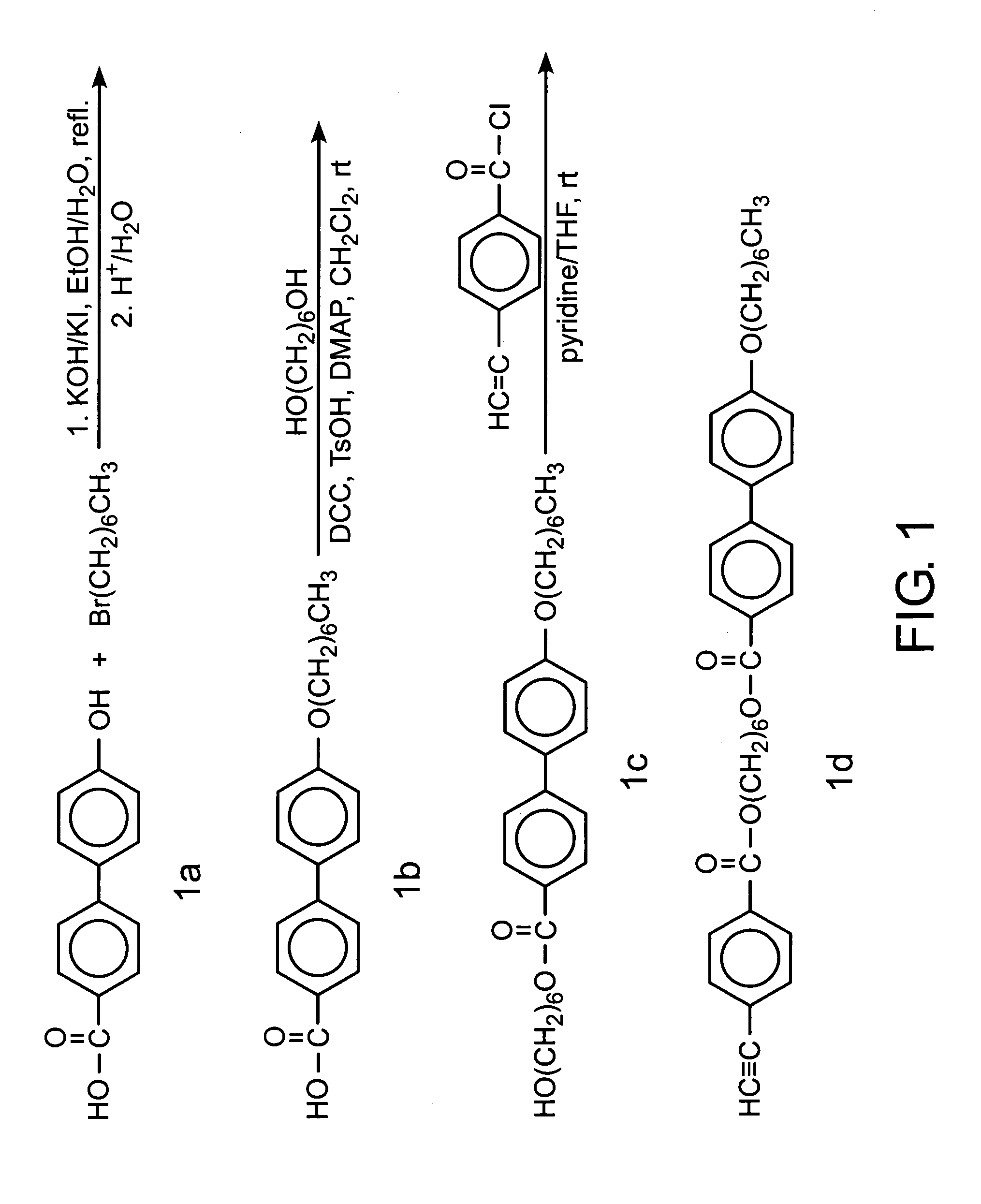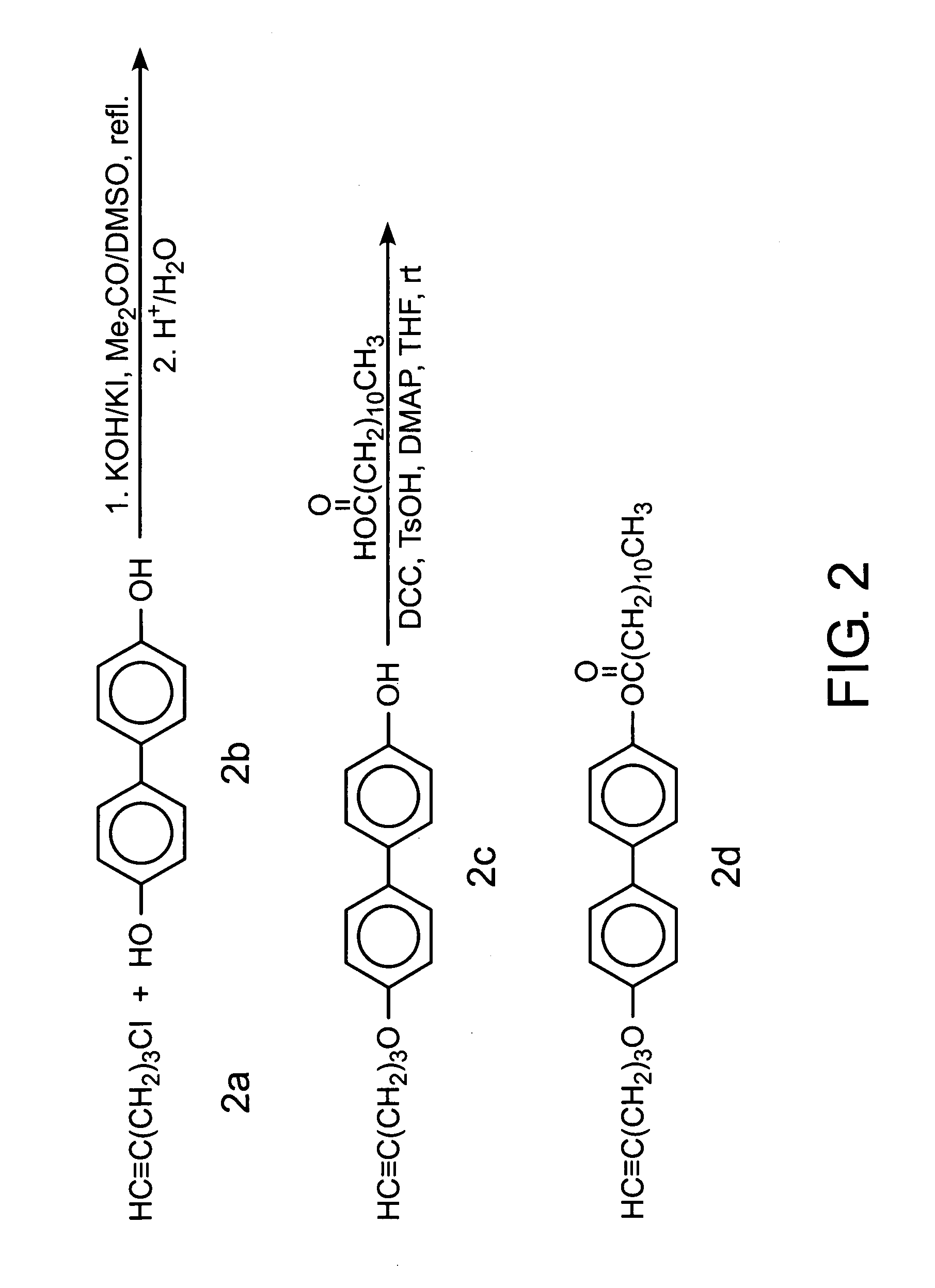Acetylene polymers and their use as liquid crystals
a technology of acetylene polymer and liquid crystal, which is applied in the preparation of carboxylic acid esters, chemistry apparatus and processes, and organic chemistry, etc. it can solve the problems of insoluble and insoluble polyacetylene, inability to bind to the polymer chain, etc., and achieve good yield
- Summary
- Abstract
- Description
- Claims
- Application Information
AI Technical Summary
Benefits of technology
Problems solved by technology
Method used
Image
Examples
example 1
Poly{[4-({[6-({[4′-(heptyl)oxy-4-biphenylyl]carbonyl}oxy)hexyl]oxy}carbonyl)phenyl]acetylene} (VIII)
[0034]
Monomer Synthesis
[0035]The phenylacetylene derivative 1 was synthesised by the multiple-step reactions shown in FIG. 1. Detailed experimental procedures and characterisation data are given below.
[0036]4′-(Heptyl)oxy-4-biphenylylcarboxylic Acid(1b). In a 1000 mL round-bottom flask equipped with a condenser, 10 g (46.7 mmol) of 1a, 5.23 g of KOH (93.5 mmol), and a catalytic amount of KI were dissolved in 500 mL of ethanol / water mixture (6:1 by volume) under gentle heating and stirring. To the solution was added 12 g (67 mmol) of 1-bromoheptane, and the resulting mixture was refluxed for 30 h. The reaction mixture was poured into 300 mL of water acidified with 20 mL of 37% hydrochloric acid. The solid was collected by suction filtration. Recrystallisation in glacial acetic acid gave 9 g of white crystalline product (yield 61.7%). IR (KBr), ν (cm−1): 3200–2300 (br. CO2H), 1684 (s, C...
example 2
Poly{5-[(4′-{[(undecyl)carbonyl]oxy}biphenyl-4-yl)oxy]-1-pentyne}(1X)
[0044]
Monomer Synthesis
[0045]The acetylene derivative was synthesised by the multiple step reactions shown in FIG. 2. Detailed experimental procedures and characterisation data are given below.
(4-Hydroxy-biphenyl-4-yl)oxy-1-pentyne(2c)
[0046]In a 1000-mL Erlenmeyer flask equipped with a condenser, 10 g (53.7 mmol) of 4–4′ biphenol and 3.3 g of KOH (58.8 mmol) were dissolved in 400 mL of acetone / DMSO mixture (v / v: 10:1) under gentle heating and stirring. To the homogeneous solution were added 5.5 g (53.6 mmol) of 5-chloro-1-pentyne and a catalytic amount of potassium iodide. The resulting mixture was then refluxed for 30 h. The solution was poured into 300 mL of water, acidified with 15 mL of 37% concentrated hydrochloric acid. The solid was collected by suction filtration, washed with water and dried in vacuum oven. The crude product was purified on a silica-gel column using chloroform first as eluent, then chlorofo...
example 3
Poly (n-{[4′-{[(undecyl)carbonyl]oxy}biphenyl-4-yl)carbonyl]oxy}-1-alkyne), n=5,6(X)
[0063]
Monomer Synthesis
[0064]The acetylene derivative were synthesised by the multiple step reactions shown in FIG. 3. Detailed experimental procedures and characterisation data are given below.
(((Undecyl)carbonyl)oxy)-4-biphenylcarboxylic acid(3c)
[0065]In a 100-mL, two-necked, round bottomed flask were added 4.0 g (20 mmol) of lauric acid, 3 mL of thionyl chloride and 20 mL of THF. After refluxing for 2 hours, the excess thionyl chloride was distilled off under reduced pressure. The solid left in the flask was dissolved in 20 mL of THF and cooled down using an ice bath. A solution of 4′-hydroxy-4-biphenylcarboxylic acid (4.5 g, 21 mmol) and pyridine (2 mL) in 30 mL of THF was injected into the flask and the mixture was slowly warmed up to room temperature and stirred overnight. THF was then distilled off using a rotary evaporator. Recrystallization of the solid residue from absolute ethanol gave 5.6...
PUM
| Property | Measurement | Unit |
|---|---|---|
| volume | aaaaa | aaaaa |
| volume | aaaaa | aaaaa |
| volume | aaaaa | aaaaa |
Abstract
Description
Claims
Application Information
 Login to View More
Login to View More - R&D
- Intellectual Property
- Life Sciences
- Materials
- Tech Scout
- Unparalleled Data Quality
- Higher Quality Content
- 60% Fewer Hallucinations
Browse by: Latest US Patents, China's latest patents, Technical Efficacy Thesaurus, Application Domain, Technology Topic, Popular Technical Reports.
© 2025 PatSnap. All rights reserved.Legal|Privacy policy|Modern Slavery Act Transparency Statement|Sitemap|About US| Contact US: help@patsnap.com



